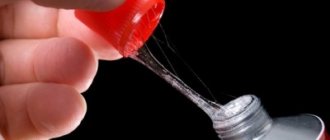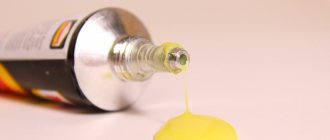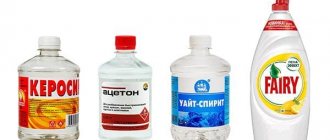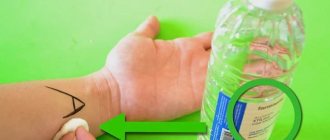Super glue is often used for various purposes, because this product has the ability to glue any objects almost instantly. However, often when using super glue or Moment glue, traces remain on surfaces, which are not so easy to get rid of.
In this article we will tell you about the most effective and proven home methods for getting rid of persistent traces of super glue on different surfaces.
What not to do?
To keep the table surface safe and sound, you need to act quickly and carefully with super glue. If glue ends up on the table, under no circumstances should it be smeared over the surface: it will be even more difficult to peel off a thin layer from the table.
Also, cleaning company specialists do not recommend using a knife or other sharp object: all traces of glue are unlikely to be removed in this way, but scratches will definitely remain on the table.
Do not use strong chemicals on surfaces on which food will subsequently be prepared.
REFERENCE! To reduce the mechanical impact on the surface, it is recommended to pre-soak it.
Have you ever scrubbed super glue off a table?
Not really
Mechanical cleaning
After the glue has been softened by the above means, it is necessary to clean it from the surface. To do this, you will need to carry out mechanical cleaning by performing a series of sequential steps:
- take a sharp knife or thin blade;
- cut off the top layer of the sticky mass, holding the knife parallel to the table;
- clean off glue residues using folk remedies or solvents;
- Finally, wipe the cleaned areas with a clean damp cloth.
It is important not to scratch the material during the procedure. Therefore, mechanical cleaning is applicable only in cases where superglue has been spilled onto the plastic in a thick layer. Minor stains should be removed using other methods.
Popular remedies for stains on tables and wooden furniture
Available means
As a handy tool, you can take children's scissors with rounded edges. And it is better to carry out not scraping movements, but pressing ones (you need to be especially careful with a glass surface).
You can also take a thin, sharp blade and carefully pry it over the edge of the glue stain.
ATTENTION! It is recommended to carry out any manipulations to clean the table with good ventilation.
Acetone and solvents
Acetone is often found in nail polish removers, so there is no need to purchase it specifically if you have nail polish remover in the house. Any solvent will also work.
Application algorithm:
- Soak a cotton pad in acetone and apply it to the contaminated area.
- Then the disc is generously wetted again and left on the dirt for 15-20 minutes.
- After the specified time, you should try to wipe the stain off with a brush or hard cloth (during the process, be careful not to leave scratches on the surface).
- If the stain is not completely removed, the procedure is repeated.
- To get rid of the smell of acetone, wipe the table with ordinary soapy water.
The main advantage of this method is the ease of its execution and the availability of funds.
IMPORTANT! Products containing acetone cannot be used to clean varnished and varnished surfaces. Also, acetone is not recommended for cleaning tables where food is prepared and eaten.
Soap
Small fresh stains can most often be removed using a gentle method - laundry soap. This option is suitable for processing dining tables, kitchen tables and children's tables.
Recommendations for using laundry soap:
- Dilute grated laundry soap in hot water (the temperature should be comfortable for your hands) until foam forms. Some housewives use ordinary liquid soap, but it will not give the same effect that laundry soap could provide.
- Take a medium-hard brush or a sponge with a hard side and rub the foam into the dirt.
- Repeat the manipulation several more times until the soap solution has cooled. If necessary, the glue can be rubbed with a brush.
- Rinse off the soap suds and wipe the table with a cotton cloth soaked in plain warm water. Allow the surface to dry naturally.
The main disadvantage of the method is that it is often powerless against large and old dried stains.
REFERENCE! The main condition for using the method is hot foam; cold foam will not give the desired effect.
Dimexide
Dimexide is a solution designed specifically to combat strong stubborn substances, including super glue. The product is sold in pharmacies and household chemical stores.
Mode of application:
- Be sure to wear gloves, moisten a moisture-absorbing sponge in the dimexide solution and wipe the contaminated surface.
- If the stain does not go away, the manipulation can be repeated after a couple of minutes.
- Then the table is wiped with a soap solution (ordinary liquid will do here) to remove traces of dimexide and odor. Next, remove the soap scum with a damp sponge.
The advantage of this method is that dimexide begins to act immediately, in the first few minutes. When using dimexide, not only wear gloves, but also open windows for ventilation, since the product can cause allergies. The drug is not used for treating kitchen furniture.
Alcohol and gasoline
Alcohol is more suitable for treating plastic and glass surfaces, but it can also be effective on wood. Removes only small adhesive marks. Alcohol can even be used to treat kitchen and dining surfaces.
Application algorithm:
- moisten a cotton pad or a piece of thick cotton cloth in alcohol, wipe the stain, and then leave the cloth on the stain for another 7-10 minutes;
- After this time, wipe the stain with a dry cloth to remove traces of alcohol.
The method of using gasoline is the same, but the liquid is not used to clean kitchen furniture, since it will definitely not be possible to remove traces of it even with soapy water the first time. You should prepare for the fact that gasoline will leave a smell that will go away for several days.
IMPORTANT! Gasoline is used only to remove already dried adhesive traces.
Temperature method
Super glue does not tolerate temperature changes well. This property of glue can be used against it. The method consists of heating it strongly or cooling it sharply, due to which the stain will lag behind the countertop.
Method implementation:
- heat the glue mark using the hot stream of a hairdryer (you can also use steam from an iron);
- wait until the dried stain begins to melt, and then scrape it off mechanically.
The second option for the temperature method is to cool the surface. It is most often possible to implement it only in winter. To combat the stain, take the table out into the cold and leave it for 20-30 minutes (longer is possible). Under the influence of low temperatures, the glue will begin to crack; all that remains is to carefully tear it off.
The advantage of the method is its safety, since the surface is not treated with any chemical elements.
IMPORTANT! The temperature method cannot be used to clean plastic countertops.
Water
This method is very time-consuming and not always effective. But it's still worth a try. It is recommended to add a few drops of glycerin and alcohol to a glass of water and mix everything well.
The resulting composition must be applied liberally to the stain and left for 10-15 minutes. Afterwards, the softened mark is removed mechanically. There is no point in removing a week old or older stain with water.
Vegetable oil
This option is suitable for treating kitchen and children's surfaces, as well as plastic and glass countertops.
Application algorithm:
- Soak a cotton pad generously in oil and wipe the contaminated area.
- Leave the disc to act for about an hour.
- After such manipulation, the glue usually softens, making it possible to scrape it off with a wooden stick.
The main advantage of the product is the absence of chemical effects on the skin and countertops.
White spirit and windshield wiper
To combat traces of glue, you need to moisten a soft sponge in glass cleaning fluid or white spirit. Leave the sponge on the glue stain until it is completely softened. As soon as the mark becomes soft, it is removed mechanically. For this, it is better to use wooden objects or those that have rounded edges.
Anticlean
This product is specially designed to remove traces of super glue. For Antiklei, the size and age of the stain does not matter: the product copes with it perfectly.
Mode of application:
- Apply Anti-Glue to the stain and leave for the time specified in the instructions.
- Afterwards, the product is removed with a sponge, and the stain is wiped off with a dry cotton napkin.
It is better not to use Anti-Glue on dining tables, as its particles remain on the surface for a long time.
Mechanical cleaning
This option is suitable if the glue has hardened in a thick layer.
Cleansing algorithm:
- Take a sharp knife (be sure to have a comfortable handle).
- There is no need to pre-wet the surface. Use a knife to carefully cut off the glue trace, while keeping the tool strictly parallel to the table surface.
- Small adhesive residues are removed with alcohol or ordinary soap solution. Afterwards the table is wiped with a dry cloth.
Attention! The only drawback of the methods is the risk of surface damage.
Do you often use super glue?
OftenRarely
Basic qualities of superglue
This remedy is often used in everyday life.
It effectively and quickly glues different surfaces. This glue has a liquid consistency. Therefore, it quickly spreads if handled carelessly and sticks to everything it comes into contact with. In particular, it can glue the skin on your hands. Then the problem arises of how to wash off the adhesive composition. The product can restore a damaged item without being noticed. Therefore, it is still popular. Important! When working with superglue, a person’s hands should be protected with gloves and their respiratory organs with a mask or respirator. If this product gets on furniture, it must be wiped off immediately.
After hardening, it is very difficult to wash off traces of such glue. What further complicates the process is that it immediately hardens upon contact with moisture, since there are no moisture-soluble substances among its ingredients. It cannot be used to connect items that contain cellulose. Once applied to an object, superglue begins to generate heat, which can lead to a fire. Therefore, such a substance is not used for paper or clothing.
How to clean depending on the type of surface?
How to quickly get rid of stains on a metal surface?
To clean a metal surface from glue stains, it is recommended to use acetone or another solvent. Step-by-step instruction:
- Soak a cotton cloth or cotton pad with acetone. Leave the dampened cloth on the contaminated surface until the glue is completely dissolved.
- Remaining glue will most likely have to be scraped off with a knife or other sharp object.
REFERENCE! Instead of acetone, you can use denatured alcohol or lighter fluid. The algorithm for using the products is the same as in the case of acetone. Hydrogen peroxide also works well.
Tips for cleaning metal:
- test the cleaning solution on a small area of the surface to see how the material reacts to the cleaning agent;
- Stainless steel is easily scratched when using even slightly abrasive sponges.
Tree
Experienced housewives claim that it is better to use a special Anti-Glue product for wooden surfaces. The best way to remove stains from untreated wood is mechanically - scraping followed by sanding.
If there is still a final stage of processing the wood and there is glue on it, it is allowed to use a solvent. Dimexide and acetone will help remove the surface layer of glue, and remove its remains with a sharp object.
For treated wood, soap solution, acetone and ethanol are more suitable.
Plastic
It is allowed to use dimexide, but only for rubbing, not soaking the material. If soaked, the plastic may break down.
You should be careful with acetone, as it can change the color of the plastic - it is better not to leave the liquid on the surface for a long time. It is better to test the effect of acetone on a small area of the surface.
Important! The most gentle way is to use ethanol, but it is recommended to use it as soon as possible.
Stains aren't just left on tables. You can find out how to clean a mattress from stains here, and a carpet here. Find out also how to dry a sofa from water, beer, and urine stains.
Anticlean
It would be best to immediately purchase, along with the second glue, a special product that neutralizes its effect. It is called “Anti-glue” and is produced by many manufacturers.
Mode of application:
- apply Anti-glue to the adhered mass;
- maintain the time specified in the instructions;
- After the chemical reaction, roll up the separated superglue with a rag.
This universal product will safely remove glue from wood, fabric, and even the skin of your hands.
Features of removing fresh stains
Fresh stains are the easiest to remove without harming the table surface. Even gentle cleansers are suitable for this.
First, it is recommended to try a solution based on laundry soap (just use hot water). You can clean the mark using an old toothbrush, the hard side of a sponge, or a medium-hard brush.
Also, fresh stains can be easily removed with washing powder. A thick paste is made from it, which subsequently acts as an abrasive component. But these options only help if the glue has not yet dried.
Learn how to remove stickers from your refrigerator at home.
Removing glue from the skin of the eyes or lips
The hardest thing to wash off is superglue from your eyes or lips. The skin here is very delicate and the use of solvents or abrasives is impossible. Therefore, only the most gentle method of removing glue is possible.
For safety reasons, you should not open a tube of glue with your teeth. But sometimes, due to inattention or carelessness, a person can break this rule. And then there is a high probability that the glue will get on the lips and stick them together.
The only way to remove glue from the surface of your lips is:
- After pouring enough warm water into a bowl, soak your lips in the liquid for a few minutes. If possible, make small movements with your lips.
- After collecting more saliva in your mouth, push it through your lips. This way, your lips will be moisturized on both sides.
- Carefully remove the glue.
You can remove superglue from your eyelids using a piece of cloth soaked in warm water. The fabric will have to be applied many times in order for the glue to soften.
What ways can damage the table surface?
To remove glue from furniture, you can use a variety of methods and compositions. However, when choosing them, you need to take into account the effect. To prevent damage to furniture, you should follow these tips:
- It is forbidden to use a product if you do not know what reaction it will cause.
- Do not use toxic compounds in enclosed spaces. Under the influence of the generated heat, they will begin to evaporate and can lead to poisoning of the body.
- It is prohibited to use chemicals to remove glue from ceramic dishes in which food is stored or prepared.
- Do not use aggressive substances after delicate formulations.
- For treating large structures, it is better to carry out a test application of the product to evaluate its reaction.
When cleaning furniture, you must take care of personal protective equipment and wear gloves. They will save you from unpleasant consequences in the form of skin irritation.
Solvents
If folk remedies turned out to be ineffective and could not soften the superglue, you will have to use chemical solvents.
This must be done carefully so as not to damage the skin of your hands and the coating being cleaned.
White Spirit
This substance is applied to a rag and traces of glue are wiped off. When the composition softens, it can be removed mechanically.
After cleaning, wipe the table with a clean damp cloth.
Refined gasoline
Remains of sticky mass can be removed using this product. You will need:
- moisten a rag with it and wipe the contaminated areas until the surface is completely clean;
- Afterwards, you can wash off traces of gasoline with a sponge soaked in lemon juice.
Do not use gasoline to clean unvarnished wood, as greasy stains will remain on it.
Acetone
Acetone or nail polish remover will help remove dried glue. The latter acts softer, but may not cope with traces of second glue. Before starting the procedure, it is worth checking the effect of the solvent on an inconspicuous area of the table.
- Pour acetone over the stained area and wait 30–40 minutes;
- After the allotted time has passed, it is necessary to remove the remaining sticky mass.
Delicious recipe! Donut cake what is it
After this, you will have to remove the smell of acetone by soaking an old toothbrush in a soapy solution and wiping the cleaned surface.
Dimexide
You can buy a potent solvent at the pharmacy - dimexide. It must be used with extreme caution, protecting your hands with thick gloves. Otherwise, you may get a chemical burn.
- lightly moisten a piece of cloth with dimexide;
- apply it to the contaminated area for 1 - 2 minutes;
- After this, wipe off the glue with a clean rag.
This method allows you to avoid the use of mechanical force. However, the solvent can corrode not only superglue, but also the plastic itself. To prevent this from happening, you need to try not to touch clean areas of the product.
Furniture care
Furniture should be regularly wiped from dust and protective agents should be applied. They will not allow the glue to penetrate deeply into the pores in case of negligence. Put covers on upholstered furniture that are easy to remove and wash, and in more severe cases, replace with new ones.
Mandatory condition: cover the table with newspaper or paper when working with adhesives. If you are repairing furniture with their help, use a brush that can be used to precisely apply the composition and not stain the surrounding surface.
Pollution is always easier to prevent than to remove.
Use the above cleaning methods if necessary, but try to keep such hassles to a minimum.
How to remove glue: step-by-step algorithm
To remove superglue from furniture, you can try different products until you find the right one. Before you
clean the surface of superglue, you need to understand what material the furniture is made of. It can be wood, plastic, fabric, glass or metal. The most delicate material is wood. If it is untreated, it should not be wetted, nor should strong solvents or oils be used. Plastic is resistant to water, friction and many chemicals. Non-aggressive solvents should be used for fabric.
The algorithm for removing marks from furniture is as follows:
- Cover the stain with tape to avoid damaging the clean surface.
- If the glue layer is thick, cut it with a knife or remove it with a blade.
- Carefully protect the remaining marks with fine-grained paper.
- Wet the stain with water.
- If the stains are old, apply solvent to them using a cotton pad or rag.
- Wait a while for the product to take effect.
- Remove any remaining adhesive by scrubbing.
After completing the process, the area should be washed with a clean cloth.
If marks are difficult to clean, use a toothbrush. If there is a large amount of glue, use a spatula. It will easily remove the adhesive base softened with solvent.











